

What Are the Most Sustainable Fabrics? - Good On You. What’s in a label?
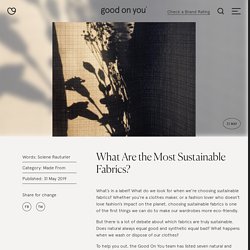
What do we look for when we’re choosing sustainable fabrics? Whether you’re a clothes maker, or a fashion lover who doesn’t love fashion’s impact on the planet, choosing sustainable fabrics is one of the first things we can do to make our wardrobes more eco-friendly. But there is a lot of debate about which fabrics are truly sustainable. Does natural always equal good and synthetic equal bad? What happens when we wash or dispose of our clothes? To help you out, the Good On You team has listed seven natural and futuristic fabrics that we think are the most sustainable. Natural Fibres Recycled Cotton Cotton is one of the most common and most used fabrics. STSC. Sustainable Textile Supply Chain. 6 sustainable textile innovations that will change the fashion industry.
Bananas, coffee, pineapple, lotus, stinging nettles and hemp - what sounds like the ingredients on an exotic shopping list are actually all natural resources that can be turned into sustainable textiles. 'How' will be explained below; 'why' should be obvious: In view of dwindling resources, especially through resource-intensive natural fibres like cotton and the environmental impact of petroleum-based fibres like acrylic, polyester, nylon and spandex, it is about time for the textile and apparel industry to look for sustainable alternatives and to prove that the production of textiles and clothing does not have to pollute the environment.

On the contrary. FashionUnited has found six interesting alternatives. 1. Eco-Initiatives For Sustainable Textiles. By Dr.
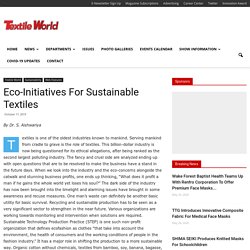
S. Aishwariya Textiles is one of the oldest industries known to mankind. Serving mankind from cradle to grave is the role of textiles. This billion-dollar industry is now being questioned for its ethical allegations, after being ranked as the second largest polluting industry. Detox Campaign, 2011 — This campaign was launched by Greenpeace as a means to expose the direct links between clothing brands, their suppliers and pollution globally. Fair Wear Foundation — The soul of manufacturing is the hands that make the cloth. Sustainable Textiles.
Eco-Design: Focal Point of Sustainable Textiles - Fibre2Fashion. With rising awareness of slow fashion, sustainability, new-generation fibres, eco-friendly processing, sustainable packaging and assessment of product life cycles, S Aishwariya and S Greeshma discuss the concept, its merits, new textile fibres and eco-fashion tags.
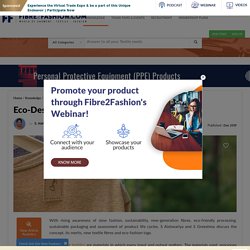
Sustainable textiles are materials in which every input and output matters. The materials used, processes involved, quality of life led by labourers and the afterlife of the product are evaluated and quantified. The resources and materials used for sustainable textiles are obtained from renewable or recycled sources. Sustainable fabrics are produced with limited impact and can be categorised in the following different ways: 1. 2. 3. 4. Textile recycling may give a new life to clothes that can't be donated to charity - Science News - ABC News. You've bought well, then made do and mended, but that favourite old shirt, skirt or pair of shoes is now beyond repair and in no condition to be foisted upon the volunteers of your local second-hand shop. But with Australians sending an estimated 6 tonnes of clothing to landfill every 10 minutes, coming up with other options than simply chucking old clothes in the bin is part of tackling our waste problem.
Restyling, upcycling and repurposing are all ways of eking a bit of extra life out of a garment. Textile recycling is often touted as the final step in this chain. So is it an option for most Australians? BlockTexx - Textile recovery technology. 'Holy grail': how textile recycling can help slash emissions, pollution and landfill. Before and after the catwalk, the fashion industry is inherently ugly.
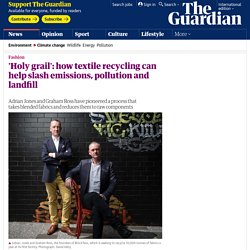
Textiles account for 10% of global carbon emissions. The industry is the world’s second-biggest industrial polluter, behind oil. 12 Ways to Disrupt the Fast Fashion Industry By Repurposing Old Textiles. Repurposing textiles to keep them out of landfills may be one of the most impactful changes you can make in disrupting fast fashion.

According to the U.S. Environmental Protection Agency, textile waste occupies nearly 5% of all landfill space in the U.S; Americans generate an average of 25 billion pounds of textiles per year. Those textiles include clothing, accessories, towels, bedding, and other home textiles. That works out to roughly 82 pounds per person per year. Circular fashion: turning old clothes into everything from new cotton to fake knees. Australia has a fashion problem.
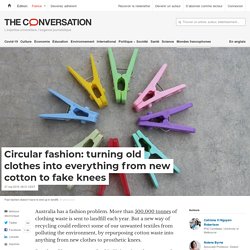
More than 500,000 tonnes of clothing waste is sent to landfill each year. Seamwork Magazine. These days, Rissanen remains inspired by Vionnet, even as he continues to push the boundaries of zero-waste design.
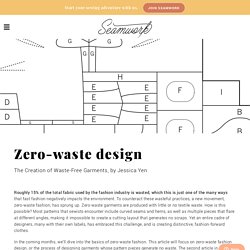
“Vionnet seemed to be endlessly fascinated by the possibilities created by the combination of fabric, the moving body, and gravity, and that is something that has stayed with me ever since I was a student,” he says. To the uninitiated, zero-waste design layouts look intimidating. The finished pattern looks like intricate interlocking puzzle pieces that emerged, fully formed, from thin air. LEARN Zero waste ENG. 7 Zero Waste Designers Who Are Just Killing It. Privacy Policy The Eluxe privacy policy applies to all your personal information, given and received.

Personal information is information that might identify you, like your name, address, phone number, email, or website. When you visit our site, we may gather information about you such as your name, email, cookie information, and IP location. We may contact you regarding your preferences for information and updates. Design Lessons In Zero Waste. ZERO-WASTE PATTERN CUTTING: ELIMINATING PRE-CONSUMER FABRIC WASTE IN THE PATTERN CUTTING ROOM. Keywords: Pattern cutting, Sustainability, Fabric waste, Zero – waste pattern cutting.

Introduction Textile or fabric waste is generated during the pre-consumer or postconsumer stage in a fashion cycle. At the pre-consumer stage, it can be fiber, yarn, fabric, and/or garments during the manufacturing process. Textile waste at the post-consumer stage maybe a garment or redundant household item. Sincere endeavors to reduce, recycle, and reuse waste generated at every stage are being carried out. Nearly 15 percent of fabric is lost as off-cuts during the pattern cutting stage in the garment manufacturing process. Slow Fashion - A Guide To Sustainable & Ethical Fashion. Our Favourite Sustainable Textiles Hemp It may seem slightly ‘hippy dippy’ to consider wearing clothes made from hemp, but as far as fabrics go, hemp is one of the most environmentally friendly. It doesn’t require the use of pesticides thanks to its ability to choke out any competing plants, and it returns 60-70% of the nutrients it takes from the soil.
The chemicals used to dye the hemp are more of an issue, so if possible try to stick to natural hemp clothing that avoids harmful chemicals. Yulex Yulex is a natural neoprene made from the rubber harvested from rubber trees and is the material SLO active use for our luxury swimwear range. Yulex neoprene generates much less CO2 during manufacturing compared to synthetic neoprene, and like the cotton plantations, these rubber plantations are sustainably managed with the help and support of local communities. Tencel. What is Slow Fashion (vs Ethical & Sustainable Fashion)? 10 Best Ethical Clothing Brands in Australia.
Spell Byron Bay. Fast Fashion Definition. What Is Fast Fashion? Fast fashion is the term used to describe clothing designs that move quickly from the catwalk to stores to meet new trends. The collections are often based on designs presented at Fashion Week events. Fast fashion allows mainstream consumers to purchase trendy clothing at an affordable price. Fast fashion became common because of cheaper clothing, an increase in the appetite for fashionable clothing, and the increase in purchasing power on the part of consumers. Fast fashion speeding toward environmental disaster, report warns. The fashion industry needs to fundamentally change in order to mitigate the environmental impact of fast fashion, experts have said. Clothes rental, better recycling processes, pollution control technology and the innovative use of offcuts are among measures that could help, they said.
The researchers produced a report – pubished in the journal Nature Reviews Earth & Environment – into the environmental cost of the industry, and how it needs to change to deal with some of the many associated problems. While the figures are debated, the Intergovernmental Panel on Climate Change (IPCC) has calculated the fashion industry produces 10% of global carbon dioxide emissions every year, while it is estimated to use around 1.5 trillion litres of water annually. Meanwhile concerns have been rising about pollution, from chemical waste to microplastics. “It is really a global problem,” said Dr Patsy Perry, a co-author of the research from Manchester University. Fast fashion companies like Zara, Boohoo, and H&M are bad for the environment and economy. The Problem with Fast Fashion. The Problem with Fast Fashion In the last two decades something has changed in the fashion industry.
Clothes have become cheaper, trend cycles have sped up and shopping has become a monthly if not weekly event for many of us. 'Slow fashion is the future': Study argues it's time to trash fast fashion. Fast Fashion in Australia - Industry Data, Trends, Stats. April 2019 Looking good: Industry revenue rises as global brands continue to grow their local operations Fast Fashion in Australia industry trends (2014-2019) Smart Textiles - an overview. Smart Fabrics Are Future of Fashion. High quality fabrics that last a long time are hard to find these day. Many garments only last a few washes. Whether for performance or aesthetic reasons, the focus within the textiles orb is on smart fabrics – from those that change their hue to those that regulate body temperature. Researchers are developing smart fabrics that do things that traditional fabrics cannot. Laser printing tech produces waterproof e-textiles in minutes.
Scientists from RMIT University have developed a cost-efficient and scaleable method for rapidly fabricating textiles that are embedded with energy storage devices. In just three minutes, the method can produce a 10x10cm smart textile patch that’s waterproof, stretchable and readily integrated with energy harvesting technologies. The technology enables graphene supercapacitors – powerful and long-lasting energy storage devices that are easily combined with solar or other sources of power – to be laser printed directly onto textiles.
Where Are The Smart Clothes? A team of researchers from NC State University’s Wilson College of Textiles embarked on a journey to learn about commercializing a smart fabric technology. By Dr. 3D printed smart textiles allow one-step manufacture of wearable tech. Most smart textiles for wearables utilise conductive fibres that are woven or knitted into the material during production, or else applied to the surface of a finished garment. But a company in the UK is taking a 3D printed approach to smart textiles. Tamicare has pioneered the Cosyflex system, which eliminates the extra steps needed to integrate conductive elements into clothing and textiles. Textilesindefencenotes2. Use of Textile Products in Defense - Fibre2Fashion. Advanced fibres and textiles. KEH-Sense is featured on WTIN - Distributed Sensing Systems Group. Fresh Developments In Fabric Tech Could Finally Push The Arrival Of 'Truly Wearable' Smart Garments.
An Introduction to Wearable Technology and Smart Textiles and Apparel: Terminology, Statistics, Evolution, and Challenges. Latest Smart Textiles & Nanotechnology News. How Smart Fabrics Are Changing the Game Across Industries. Visible boost for e-textiles.